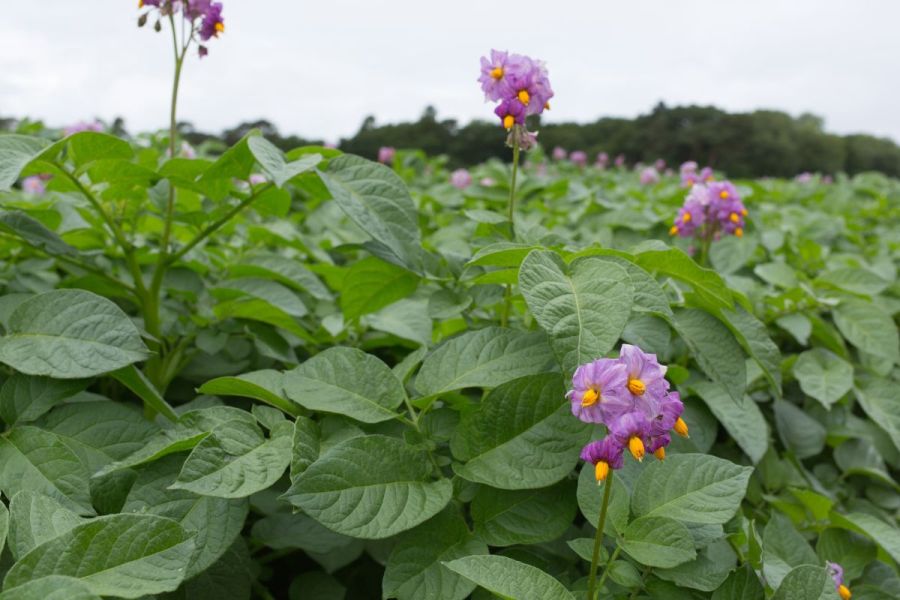CUPGRA’s 33rd annual conference in December highlighted some of the latest research and thinking on how the potato industry can overcome some major agronomic challenges that are developing, particularly when it comes to limiting damage from PCN with the possible loss of nematicides in the near future. CPM reports.
“The industry isn’t doing enough and can do more.”
By Mike Abram
The potato industry could be in the last throes of using granular nematicides for coping with potato cyst nematode infestations. Just one remains – Nemathorin (fosthiazate) – and its approval is currently under review in both the EU and UK.
While its current expiry date has been extended by a year in the EU, to 31 October 2023, the UK authorisation currently expires a year later, with last sales by 30 April 2025 and another year to use up stock.
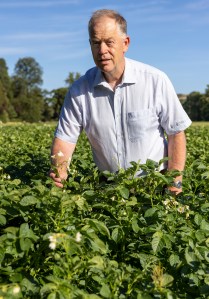
Eric Anderson explains that the UK’s last remaining nematicide is currently under review, with a future that’s anything but guaranteed.
A re-registration would extend both these dates further, but there are no guarantees for this in either the EU or UK, explains Eric Anderson, senior potato agronomist with Scottish Agronomy. Both Syngenta and ISK, the approval holder, are committed to supporting re-registration and have invested in relevant studies to meet regulatory demands.
“The outcome of the EU review will probably give us an indication of the probable course of travel in the UK,” suggests Eric.
With an uncertain future for granular nematicides, Eric believes the industry needs to act now to prepare for that possibility, with actions required throughout the supply chain – from retailer, to grower, to laboratory testing facilities.
A key starting point is understanding your enemy, he says, and in the case of PCN that’s whether Globodera pallida, Globodera rostochiensis or a mixed population is present.
The most recent PCN survey in 2016 clearly shows a further switch to dominance of G. pallida over G. rostochiensis, with 89% of populations comprised of G. pallida compared with just 5% for G. rostochiensis, and just 6% mixed.
‘The most plausible explanation for this is the intensive use of resistant varieties to G. rostochiensis,” suggests Eric.
In Scotland, just 2% of the potato area is planted with varieties which could be classified as resistant to G. pallida, with resistance ratings of 7-9. Conversely, 83% of the area is plnted with susceptible varieties, with an average rating of just 2.2, he says.
Using AHDB’s PCN calculator suggests growing an intolerant, susceptible variety without nematicides would need a rotational length of 13 years to be sustainable, highlights Eric.
“Looking at the varieties grown in East Anglia in the processing, chipping, crisping and ware sectors, there’s a similar issue. The industry isn’t doing enough and can do more. We need to focus on the [short] timescale and change direction to varieties that are sustainable.”
That will require more acceptance from end users when it comes to planting alternative varieties, and for retailers and processors to engage to make changes. With it typically taking 10 years to breed new varieties, and five years to breed up greater quantities of commercial grade seed of existing varieties, there is an urgency for the industry to respond, he points out.
Breeding varieties with good G. pallida resistance is complicated by the greater genetic variability in its strains in the UK compared with G. rostochiensis.
“For G. pallida, durable resistance is a polygenic trait which makes it more difficult to breed for,” explains Eric.
That variability could potentially also cause unintended consequences in the field, he adds. “If grown frequently, partially resistant varieties may lead to selection of virulent populations that will pose a challenge for deploying resistance that is both durable and effective.”
Resistance is only half the battle though, with tolerance also required to maintain yields in the presence of PCN. But currently there are no molecular markers for tolerance which would help make breeding for it easier, although research might have made a potential breakthrough recently.
Usually tolerance is assessed in field trials by comparing relative yields with and without nematicides. But field trials take a long time and are expensive, so crop height is being tested as a proxy – this could give data in just nine weeks in glasshouse trials.
While stem height isn’t purely a genetic trait, there is a clear trend for known tolerant varieties to be taller in both field and glasshouse tests. Combining that with the knowledge that indeterminate varieties are taller, research is ongoing to see if there is a link that could allow genetic markers for determinacy to be used for tolerance, explains Eric.
Progress is being made in breeding new varieties with G. pallida resistance for processing and chipping markets. “But the problem is some have very little tolerance. For example, Innovator has strong resistance but very little tolerance, so won’t yield in the presence of PCN without nematicides. It’s also susceptible to tobacco rattle virus, which is spread by free-living nematodes.”
Elland, which its breeder Cygnet PB suggests can be used for chipping or pre-pack, is one with good resistance to G. pallida and stands out for its relatively good tolerance, says Eric, while some other varieties – such as Karelia and Amanda – also have good resistance, for example.
Testing for PCN will also need more investment if granular nematicides disappear, he highlights. “Without nematicides you need to know which species of PCN is present and sample at a high enough soil volume to detect accurate eggs and juvenile numbers, not just cysts.”
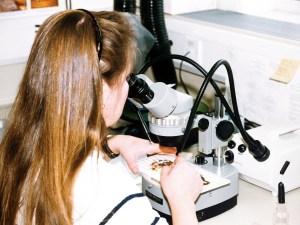
Evaluating soil sub-samples for cyst numbers isn’t sufficient – knowing both the number of eggs and juveniles in a 400g sample is required, along with speciation of the PCN present.
Current laboratory tests effectively fail in all three regards, says Eric, partly because with the crutch of granular nematicides such information was less critical, using lower soil volumes, not doing speciation, or counting eggs and juvenile numbers.
For accurate PCN detection, soil samples of at least 400g are required, especially where lower populations which are spread spatially in the field are present. Currently, most labs will subsample and use only 100-200g, which lowers the probability of cyst detection significantly, while there is very little correlation between egg and cyst numbers.
“Getting accurate results back on eggs and juveniles per gram of soil is fundamental in driving the decision on variety and what your management will be without nematicides,” he stresses.
Improving procedures to provide those results in future requires capital investment so that the testing facilities can cope with the extra workload and accuracy required, including using the qPCR kit available to automatically detect PCN species accurately.
“The farmers can’t absorb all that cost, so fundamentally the packers, processors and crispers have to pay a realistic amount for the rising cost of growing potatoes, because there is cost involved in adopting an IPM strategy.”
Key agronomic messages from the CUPGRA conference
Does free-living nematode damage open the door for blackleg?
Latest research from the DeS-BL (Building a Decision Support Tool for Potato Blackleg Disease) project is providing evidence of a link between free-living nematode damage to potato roots and infections by Pectobacterium atrosepticum (Pba), which causes blackleg.
Primarily infections are introduced via seed but five years ago research showed blackleg developed on irrigated, non-infected first-generation seed, leading to new areas of research.
One of these projects is centred on free-living nematodes after preliminary data showed that potato plants, grown in the presence of Pba and a mixed population of free-living nematodes, had 100-fold bacteria increase in plant stems compared with plants grown without free-living nematodes.

Research is providing evidence of a link between free-living nematode damage to potato roots and infections by Pectobacterium atrosepticum (Pba), which causes blackleg, says Prof Ian Toth.
“We haven’t shown it causes more blackleg,” says Prof Ian Toth from the James Hutton Institute. “But with 100 times more inside the plant, the suggestion is that it does.”
Follow up work used a laser to cause damage to a potato root and demonstrated Pba, which is found ubiquitously in soil, moves to colonise the damaged part of the root within 30 seconds.
A number of unanswered questions remain, says Ian, including proving whether free-living nematode damage causes a similar effect, which isn’t easy to design an experiment for.
Another area of intrigue is what prompts the bacteria to move from root to stem. In experiments, the bacteria stayed in the root which Ian suggests could be due to the fact that in very young actively-growing plants, the roots fulfil all the bacteria’s nutrient needs.
“In the field, is there some physiological change that prompts bacteria to decide the best bet is to move into the stem? But we have no idea what that signal might be.”
Should irrigation management change for blackleg?
The finding that irrigation is an exacerbating factor for blackleg is also leading to new ideas about irrigation management for the disease.
Trials conducted by NIAB CUF as part of the DeS-BL project used different irrigation regimes on crops of Jelly and Estima.
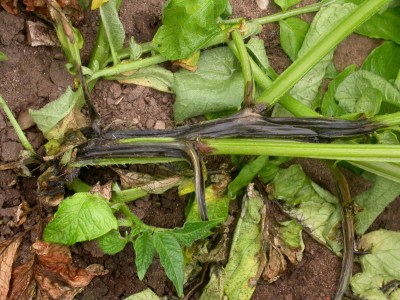
The finding that irrigation is an exacerbating factor for blackleg is also leading to new ideas about irrigation management for the disease.
Blackleg infections were highest on crops irrigated through the season, with lowest levels on non-irrigated crops, reports Simon Alexander, an independent potato agronomist.
Following an irrigation schedule to minimise common scab resulted in high blackleg infections, while the irrigation schedule for processing crops – where scab control is less important – resulted in a slower increase in blackleg infection during the season.
The link between irrigation and blackleg could require a shift in thinking about irrigation management depending on end market and storage plans, he suggests.
“Take Challenger and Markies in the processing sector – both are very susceptible to blackleg. If I’m growing either for harvest movement, I’m going to go for yield. I’ll push irrigation and if we get a bit of blackleg, we can grade it out.
“If I want to store that crop until March or later, it will have a very different requirement. I don’t want to be putting any more rots into store than is physically possible. On that basis, stretching irrigation, a little more than perhaps is desirable for optimum yield, to maintain quality is worth considering.”
Handheld soil sensor could help increase N use efficiency
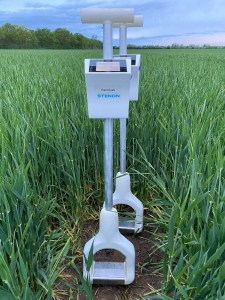
Handheld soil sensor could help increase N use efficiency.
Determining nitrogen inputs employing a data-driven approach, using real-time results from sensors on a soil sampling probe, has shown potential to reduce nitrogen inputs by 20% without impacting potato yields.
The sensor technology used in five trials in the UK and Germany was developed by German company Stenon. It has three sensors built into the hand-held device – near infrared, ultraviolet-visible, and electrochemical impedance spectroscopy – which provide data on nine parameters, including soil mineral nitrogen, phosphorus, organic matter and soil organic carbon, soil temperature and moisture, and pH.
Using the device reduced the turnaround time for results compared with sending to a lab.
In a split field design, mineral nitrogen was measured twice by the Stenon FarmLab, before planting and before the second fertiliser application. These values were then used to make fertiliser recommendations which were compared with the farm standard practice, explains Kim ten Wolde, global program manager for Stenon.
It takes about 20 seconds to take a measurement, with three taken at each spot, he says. With cleaning of the sensor between measurements, typically it takes 5-10 minutes per location.
The probe measures to a depth of 15cm, with the data uploaded to the cloud and processed by Stenon’s algorithm, which has been calibrated to provide a nutrient value that equates to a soil sample from a depth of 0-30cm, explains Kim.
On average, using the Stenon FarmLab reduced nitrogen requirements by 20%, with no statistically significant impact on yield. “There was also an increase of up to 72% in nitrogen use efficiency. If we can improve efficiency in the field by 30%, it would make a huge difference in the way fertiliser is used.”
New bait traps helping assess wireworm risk
Wireworm bait trap reliability is continuing to improve as more trials are being carried out, according to Martyn Cox, an independent agronomist at the forefront of wireworm management.
Soil temperature is critical when bait trapping, he says. Wireworms aren’t active below 8⁰C, so Martyn suggests 10⁰C as a good figure to use for baiting. He notes that the autumn is proving to be more reliable than spring for trapping as the soil cools down from the surface, while in spring it warms up from below.
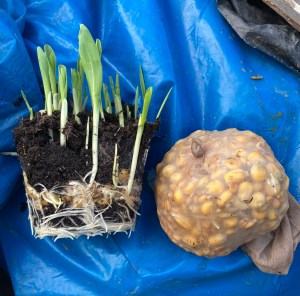
Damage caused by wireworm is on the increase but the good news is that the reliability of bait traps continue to improve as more tests are being carried out.
“Ideally, soil also needs to be fairly dry – not bone dry – and definitely not saturated as wireworm mobility is poor in wet soils and it reduces air spaces for the volatiles that attract the wireworms to move into,” he advises.
Martyn’s now using a 50:50 mix of wheat and maize for his traps, rather than wheat and barley. He also emphasises that it’s important to use good quality maize seed that will grow, without any pesticide seed dressings.
“It’s not just the carbon dioxide given off when the maize seed germinates that attracts wireworms, but also other plant volatiles in the roots that confer more attraction. You can get attraction to chopped maize roots, which aren’t giving off carbon dioxide.”
Trap design is less critical, but this autumn he’s tested pre-growing traps, which have worked effectively. “One advantage is it gives less time for badgers to pull the emerging seedlings out of the ground.”
He pre-soaks the cereal seeds to stimulate germination, and then plants out in pots with compost. “Once the leaves have emerged it holds together nicely to plant out in the field,” he says. “We’ve caught larvae in just four days.”
But trials this autumn confirmed are unlikely to be reliable in predicted sub-optimal conditions, he says, catching less than 0.25 wireworms/trap in wet soils below 8⁰C, compared with over three per trap in optimal conditions (drier soils, over 8⁰C).
This article was taken from the latest issue of CPM. For more articles like this, subscribe here.

